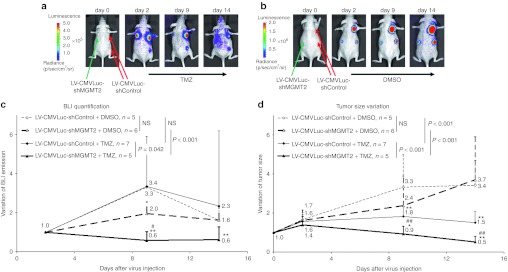Figure 5.

Combined anti-O6-methylguanine-DNA methyltransferase (MGMT) gene therapy and temozolomide (TMZ) chemotherapy induces an inhibition of the tumor growth of resistant glioblastoma (GBM) xenografts. LN18 wild-type cells were xenografted in nude mice (four per animal). The lentiviral vector expressing the luciferase reporter gene and the shMGMT2 sequence (LV-CMVLuc-shMGMT2) was injected into the left tumors (obtained: ntumor = 11 in nmouse = 10). The lentiviral vector expressing the luciferase reporter gene and the control small hairpin RNA (shRNA) sequence (LV-CMVLuc-shControl) was injected into the right tumors (obtained: ntumor = 12 in nmouse = 10). Two days after virus injection, mice were divided in two groups and treated with daily intraperitoneal injections of (a) dimethyl sulfoxide (DMSO) or 50 mg/kg TMZ (b). At day 0, 2, 9, and 14 the bioluminescence emitted by the xenografts was (a,b) measured and (c) quantified. Tumor sizes were evaluated by caliper measurements and size variations upon treatment were plotted against the (d) duration of treatment. All data are presented as mean + SD. Two-way ANOVA tests were used to analyze the differences between DMSO- and TMZ-treated tumors, and between tumors injected with the LV-CMVLuc-shControl and the LV-CMVLuc-shMGMT2. Pair wise multiple comparisons were analyzed using Holm–Sidak method. CMV, cytomegalovirus.
